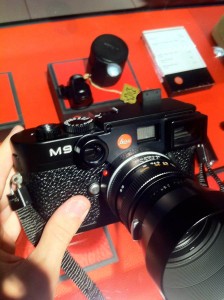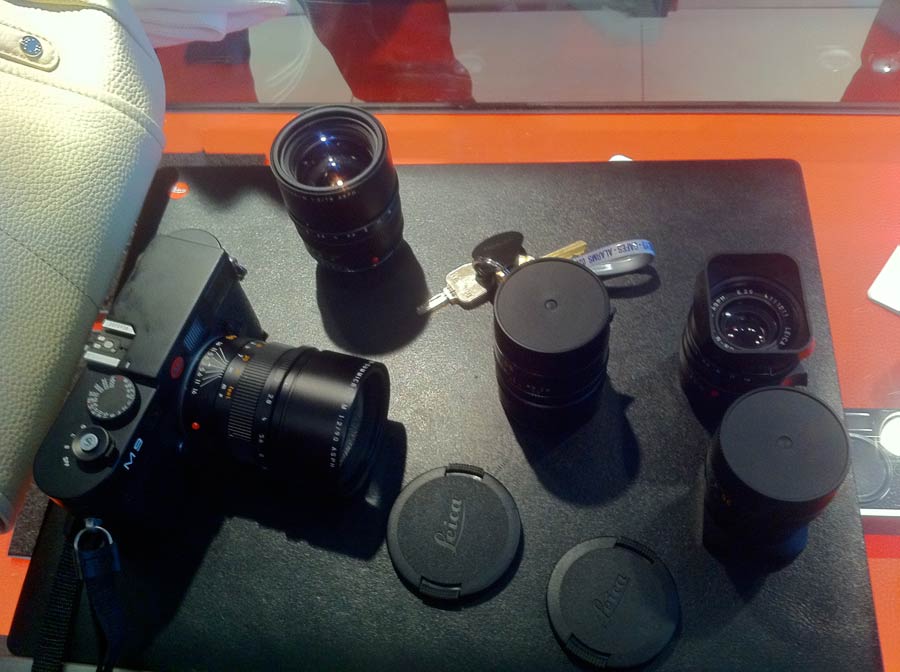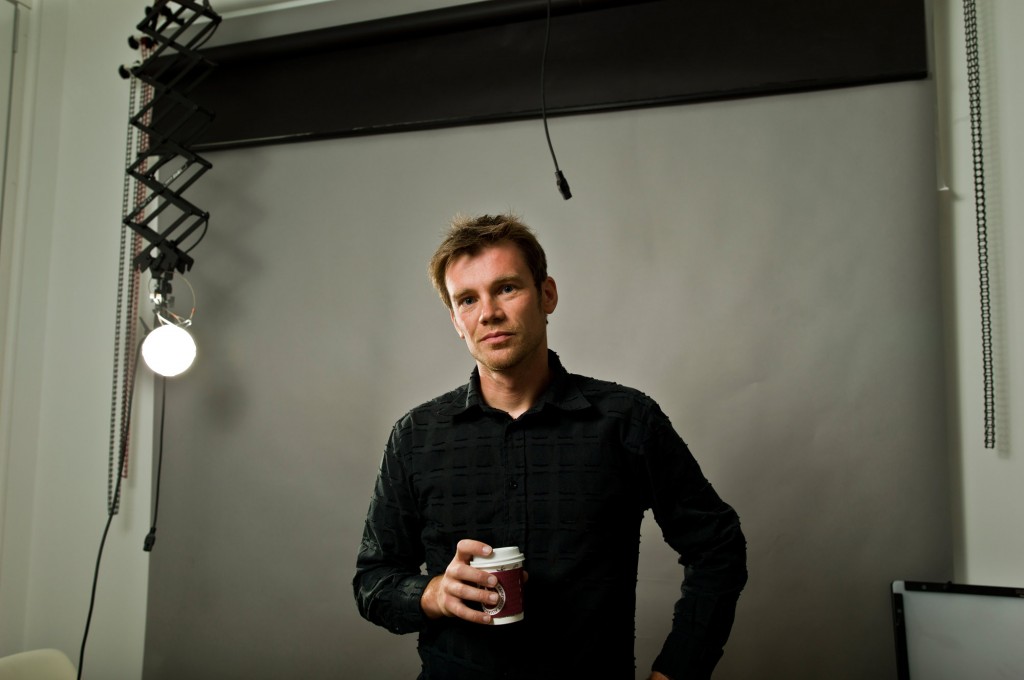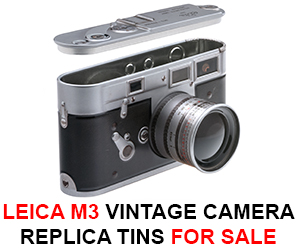Today’s guest post about the Leica Store Mayfair and the Leica S2 camera is written by Brian Hirschfeld:
Leica has stores? yup. They have all of their products in them? yup. And they actually sell them? yup*. That last yup* indicates a slight caveat to this answer. While they have every lens on display, they don’t have every lens in stock. In fact they are severely lacking in stock, just like every other place on the planet. They can’t be faulted for this and it is the worst thing I have to say about them .
Granted the store is a bit of a tease because you enter and are immediately awed by the fact that they have EVERY LEICA LENS (on display). You can see, you can touch, but you can’t buy. Everything you dream of from a 50 Summilux to a 90 Summicron; but you can’t buy them. The staff is very good as well. Knowledgeable about their products, as well they should be. Not only do these people work in the store but they are also photographers in their own right who have actual practical experience with the products. Since Leica is rather expensive the fact that some of the employee’s own multiple M9′s with assortments of exotic, (even for Leica) glass, astounds me. If you walk into the store with one of their products, they love you that much more. This is not to say they will not help you if you don’t own a Leica, but having one certainly doesn’t hurt in terms of overall hospitality. I didn’t have anything to do for the afternoon so I decided to walk over and check out the place.
They are very happy to let you mount any lens on your camera as well as let you take demo shots with it. This is one of the key purposes of the store. The Leica stores are there to provide access to their products and get the word out about them. Granted this is undermined by the fact that they are tucked away in an alley in one of the most exclusive areas of London (Holland and Holland is also on this Alley/Street though).
Having the Leica 50mm Summilux (a lens I have had on order from my camera store Camera Wholesalers of Stamford, CT since I purchased the Leica M8 when it was new) was an ethereal experience. In my opinion there is absolutely nothing like shooting with this lens. The Leica store employee who was helping me strongly agreed with me furthering my point by saying that the full-frame Leica M9 was made for this lens and that this lens was made for the M9. The 35mm Summicron was also another interesting experience. I had almost exclusively used my 35mm Summarit on my M8 and M9 and had an intimate knowledge of it. The 35 Summicron is as well built and smaller, but not too much so that it causes a problem. It is unobtrusive in every way. Wide open it does have better performance than the 35mm Summilux to some. I am not sure but I might be slightly more in the 35mm Summicron’s camp. Both lenses are superior and if you use them stopped down the way you will normally use any lens the difference would be negligible.
The Leica 75mm and 90mm Summicron’s were more interesting to me though. I had never used a telephoto lens on the M9 (other than a brief encounter with the 135mm). There is no legitimate reason to own both of these lenses. Either way it is most likely going to be the longest lens you will own. That is unless your Audrey Toutou and this is a Chanel No.5 Commercial. Or if you are an Asian businessman who insists on having every current Leica lens even the useless 90mm Macro (read on for more about this lens). Both of these lenses are exceptional but the 90mm Summicron is the standout. It is as sharp as you can get without cutting something when you get it in perfect focus wide open. Stopped down it is unbelievable. The 75mm Summicron is as good as any other lens. It is sharp, well built, and performs like a champ. However the 75mm focal length is a little too close to the 50mm focal length for me to see any practical use it. I don’t know if I will go out of my way to purchase a 90mm Summicron since the Leica M system really isn’t about the telephoto end focal lengths. They are there, you can do great things with them, but as the focal lengths increase they become increasingly inconvenient to use because of their size blocking the viewfinder.
 The 90mm Macro-Elmar f/4 is one strange lens. There is nothing to say that this lens is not a legitimate “Leica” lens, it is. It’s just as Marty Feldman while playing Igor would say “Abbynormal”. Now on Earlier Leica cameras there were fewer frame lines and viewfinder magnification was a problem for certain lenses. This is why earlier lenses like the 35mm for the M3 camera had pieces that were put in front of the camera’s viewfinder and its coupled rangefinder.
The 90mm Macro-Elmar f/4 is one strange lens. There is nothing to say that this lens is not a legitimate “Leica” lens, it is. It’s just as Marty Feldman while playing Igor would say “Abbynormal”. Now on Earlier Leica cameras there were fewer frame lines and viewfinder magnification was a problem for certain lenses. This is why earlier lenses like the 35mm for the M3 camera had pieces that were put in front of the camera’s viewfinder and its coupled rangefinder.
The Assembly is the first place where this lens gets weird. The fact that the word assembly can be justly applied to this lens should be noted. When I say assembly I am not referring to the painstakingly detailed process of creating the elements and fitting them all together to create a masterfully constructed optical instrument..In effect I am only talking about mounting the lens on the camera. However this is not a simple on-the-fly process like it is with almost any other lens on almost any other camera. First off you remove whatever normal lens you have been using. Then you swallow your pride and mount the viewfinder modification piece (I’m sure there is a more technical name for it). Then you mount the lens. Then you reposition the lens. This is because you have to extend the front part of the barrel to be able to use it as a macro lens. Now it really gets weird. So you have mounted the adapter on the camera, you have mounted and positioned the lens, but your not done. To use this lens in any useful way you have to use the vertical viewfinder adapter for the M9. Now this isn’t a Hasselblad V series camera, or a Rollei TLR, it’s a Leica M; a rangefinder. You take this weird little piece of metal and glass and you look at it. You see there is a wheel that you can spin and figure out it must be screwed onto something. However you can’t really figure out how to put it on the viewfinder. You then think that somehow you need to take off the rubber piece over the viewfinder; BUT NO! it goes on over it. Getting even stranger after you have screwed this onto your camera, look through it and it’s everything you don’t want in a lens; confusing and disorienting. However, after a little time you get used to it. You get used to it just in time for the novelty value of it to wear off and you to realize there are better ways to spend $5,000.00 in the world of Leica.
Now, on to the most interesting aspect of the Leica store as well as this article….The Leica S2 review.
The Leica S2
At the time that I was in London in mid-July I still had not decided what new medium format digital capture system I wanted to upgrade to. It was up in the air between the Leica S2 and the PhaseOne 645DF and IQ180 back. Since then I decided to purchase the IQ180. I made this decision because for effectively the same price (with the trade in value of my Hasselblad H3Dii-39ms). Anyway back to the point right now, I was at the Leica store admiring all of the lovely Leica M products that I wouldn’t be able to get for the next 100 years because of backorders, when I brought up the Leica S2 which they had multiple examples of on display. The employees were just as eager to show off this system to me, especially after I had expressed interest in it as an upgrade (really more of a side grade sensor wise) to my Hasselblad system. Then I was able to play with the Leica S2 and all of its current lenses as if I was in a camera store..
When I say “as if I was in a camera store” because there is a specific way that you look at a camera in a camera store. You are able to touch, hold and use it. Sometimes you may even be able to take it outside, but overall you take some snap shots and then you hold it a while longer while talking to the salesperson and then you either buy it, decide to go home and look at the files, or you don’t buy it. This process is curt and can rarely give you the depth needed to understand the camera and its capabilities and shortcomings. The Leica store employee I was talking to told me that the store also had a professional services division. This means that they had a service center, as well as an office where they had classes and other events for professionals. The employee told me that I could contact someone in their office and would be able to have a studio session with the camera (Leica S2) where I could get a bunch of sample images that I could look at and help to make a decision about the camera.. At no point while I had my demo-session with the camera was there any pressure to buy the camera or any mention at all. I found this particularly interesting and relaxing especially since it is a significant investment and they did go to some trouble to give me the opportunity to have the demo session. At one point I was asked more out of curiosity by the man giving me the demo session where I thought I would buy the camera if I chose it? I told him I would probably by it in New York since that’s the closest place to me, and that was the end of that topic it was not mentioned again.
Now onto the Demo session; I contact the man I was told to about setting up the demo session and left a voicemail. It turned out he was on vacation with his family however he still contacted me later that day and said that although he would not be able to conduct the private demo session himself, he would find someone else who had extensive knowledge with the camera system who could conduct the demo. He was able to get photographer Ian Farrell to conduct the demo session. He is the man in the picture above. There are other images that can be seen on my flickr through this link. He was great and was able to talk about the system in detail because he uses it and was able to show off all of the different features that it had available. He also brought some of his Elinchrom quadra lights with him (since the Leica store had sent their lights out for repair) which of course made it a studio and a place where I could get images under controlled lighting to understand the camera better. Then we walked around outside and I was able to get some natural light images as well. Outside we got some looks because it was a big camera in a young man’s hands with a grown man behind him carrying the bag. Overall it was a very good experience.
Some thoughts about the camera: In the past I have had the opportunity to hold the Leica S2 in the traditional “camera store” way at Camera Wholesalers in Stamford on a Leica day as well as at PDN PhotoPlus in NYC. These had given me an idea what the camera felt like and how it was built. As is to be expected with any Leica product it was really, really well built. Every part of it felt solid and it is heavy but not too heavy. It is lighter and smaller than any other medium format system as well. In London I had the opportunity to use this camera with the vertical grip. A vertical grip is something that I really like about professional DSLR’s like the D3 and the Ids series of cameras. The Leica S2 and the PhaseOne 645DF are the only current production medium format cameras that have the option available (the older and possibly superior Contax 645AF system had a vertical grip as well). Holding the Leica Vertical grip on its own it felt a bit flimsy however when it was on the camera it felt just right. When I mentioned this to Ian Farrell he agreed with me. He also added that if they created the grip out of metal like the rest of the body of the camera, it would have greatly increased the weight. While it is made of plastic it is still fully weather sealed like the rest of the camera and attaches sturdily to the base of the camera. In pictures it makes the camera look significantly larger. However, in reality it is less pronounced then it appears in photographs. It works perfectly for what it is. The built quality, ergonomics and basic functionality of this camera are superior in every way to every other system currently available. But it is still not the best camera on the market.
While the Image quality is good on this camera, it is not the biggest and best that they have now that there are 60-80mp sensors on the market. When the camera was announced it had a standard sensor for medium format with the highest resolution, the 60mp category, being lead by PhaseOne’s landmark P65+ (and some impossibly named Leaf equivalent). The camera preforms admirably at all ISO’s. This is something that cannot be said of most medium format DSLR’s which top out their total ISO’s at 800 and their usable ISO’s at 400 typically. The Leica S2 though tops out at 1250 and produces highly usable results at this ISO (see my flickr page for comparison shots of all of the S2′s ISO’s). Here it definitely gets major points. Yet, the complaint I have with it, especially after using even higher mega-pixel backs like the PhaseOne P65+ and Hasselblad H4D-50, is that it doesn’t have the same ability to crop the way a 60-80mp sensor would. I found that this can also be said for the 50mp Hasselbald which I will have a review of posted soon. The image quality is far better than that of any 35mm DSLR and is on par or better than most medium format sensor’s. The area that differentiates the S2 most from all other cameras is its lenses which effect the image resolution greatly.
In the Leica S2 particularly, the lenses are the real show stopper for many reasons. The key ones are:
First off is the fact that is has AUTOFOCUS! This is a first for a Leica Camera. For years the CEO’s and designers had clung to the manual focus mantra. With the Leica R series, a highly underrated system technically speaking (in terms of lenses) which largely flopped due to a lack of features,.particularly autofocus which was already standard on the Asian imports. Leica knew that they couldn’t market a medium format DSLR camera that did not have autofocus to the professional market. Well they did this and the autofocus system is as good as any other medium format system; which is to say crappy. But if everyone else is crappy and you’re slightly better than crappy you get points, and they did. The autofocus works just fine, just know its limits and timing. The Leica S-Line of lenses perform better than any other lenses I have ever used. They add so much to the camera it is almost impossible to describe their impact. They make the system and they are the main selling point. Aside from being distortion free (on the wider end) and free of vignetting at all apertures they handle ghosting and flaring amazingly well. The image I show at the beginning of my Leica S2 review section is the perfect example of this. The image was taken with the 35mm Summarit S lens. The composition includes the subject as well as the backlight (there were two lights and the key light with umbrella was in front) With other lenses in other systems there would be ghosting and flaring issues from the light . As you can see from this image there is absolutely none. You have to zoom in on the larger quality image (which can be accessed by clicking on the image) where you can zoom in on the light and see how clearly defined the edges of it are. This is truly the magic of the lens design. They are perfectly designed and absolutely perfect. If only they could be used on a PhaseOne 645DF. The only true problem with these lenses is the fact that there are so few of them. Yes there are a few adapters which can be purchased that allow you to use other lenses like Hasselblad V series lenses on the S2 body, however they are manual focus and there is obviously no communication between the lens and camera. Leica has recently released their own adapters which allow you to use other companies lenses (Mamiya 645, Hasselblad and Pentax). These adapters are decidedly better built and definitely help to expand the system to users of other lenses from their film cameras. Yet the system does not have enough lenses at the moment. Hasselblad and Mamiya currently have around 20 lenses available for their cameras respectably. All of these autofocus lenses cover focal lengths from ultra-wide (28mm remember this is medium format) to telephoto (300mm which is equivalent to around 180mm’s in 35mm language). The S2 only has a 35mm, 70mm, 120mm and 180mm lens. Three of these are at the aperture of f/2.5 which is at least a stop faster than many of their counterparts. There are other lenses in the roadmap. From conversation I understand that next will likely be a 28mm ultra-wide, a tilt-shit, and zoom lenses. The system will develop, but that takes time. TIme which is recorded by cameras in split-second increments. If you don’t the capability to do what you want, when you want, it is meaningless whether they will be announcing a new lens in the future.
The Leica S2 is a great camera. It is not the best but it serves a specific function which it does better than any other can. The only other camera that defied the traditional medium format form factor that had the sensor built into the body of the camera and they were inseparable was the Mamiya ZD DSLR. I don’t include the Pentax 645D in this statement because it still has the basic form factor of a medium format DSLR even though it is still self contained. The Mamiya ZD was clunky and difficult to use and consequently did not catch on and that is why you probably never had an updated version of it in this form factor. I think the Mamiya ZD was an admirably first effort. It established that this kind of camera could be made and could generate some interest. Leica was able to truly take a risk (particularly financially especially after the disastrous R8/R9) and Leica’s financials since the release of the S2 speak for themselves. While during this time the M9 was also released. The great successes can be seen by the Leica S2′s success. The Leica S2′s success helped to create even more cache around the brand which certainly did not hurt the M system and other optical divisions that share the Leica brand name.

















